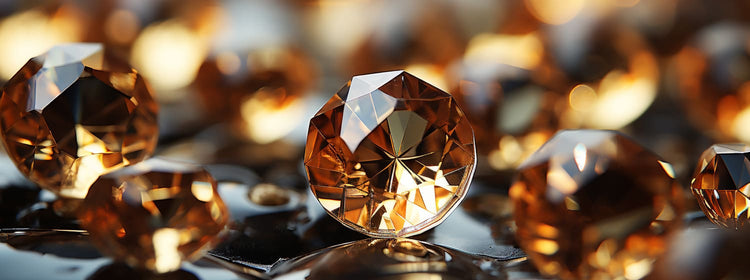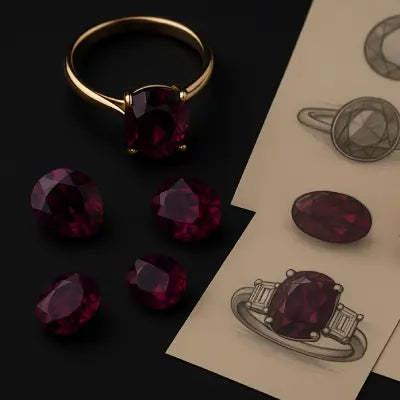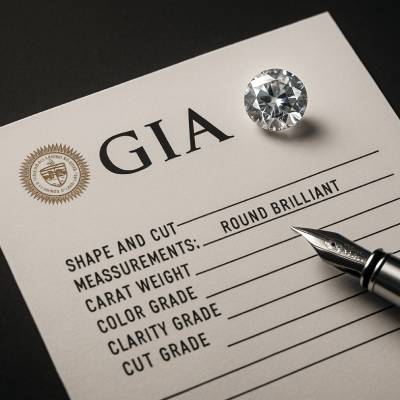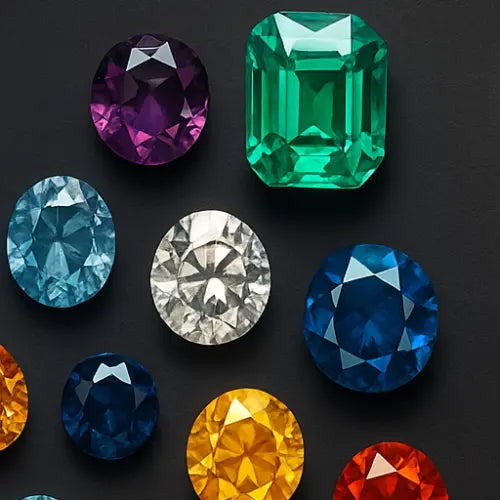What Materials Are Used to Make Jewelry?
Have you ever admired your bracelet and wondered: what is jewelry made of?
The world of jewelry-making boasts a surprising variety. There are materials as diverse as the designs themselves. We're not just talking about gold and silver anymore!
We will go from precious gemstones that burst with color to natural ones like seashells and wood. So, now, designers have a vast palette to choose from.
Our article will unveil some of the most common things used to craft these jewelry pieces. We will give you a deeper appreciation for the artistry behind every piece.
Introduction to Jewelry Materials
Accessories aren't just about sparkle and shine. They’re about a world of components that bring a designer's vision to life. The variety of materials used in jewelry-making is astounding, offering options for every style and budget. Have you ever wondered, "What is it made of?" Did you search for "materials for making jewelry"? This block will unveil the fascinating world behind your favorite pieces:
- Precious Metals. Gold, silver, and platinum are timeless classics. They're prized for their beauty, durability, and symbolic value. They're often used in their pure form or alloyed for strength. These create elegant settings for gemstones or stand out on their own.
- Gemstones. They come in a mesmerizing array of colors, cuts, and clarities. Diamonds, sapphires, rubies, and emeralds are the "Big Four." Meanwhile, countless others, like opals, amethysts, and tourmalines, offer a spectrum of possibilities.
- Other Natural Components. Nature's bounty extends beyond gemstones. Seashells offer a touch of the ocean. These materials are popular to make earrings. Meanwhile, fossilized components like amber add a touch of ancient history.
- Man-Made Components. The realm isn't limited to what nature provides. Creative designers incorporate everything from sleek stainless steel and lightweight titanium to vibrant glass and colorful acrylics.
Metals Commonly Used in Jewelry
When it comes to "which metal is used to make jewelry," the answer is a big amount! But a few stand out as the most popular choices, each with its own unique properties:
- Gold. It's a timeless symbol of luxury. Gold offers a warm, radiant glow. Pure gold is quite soft. So, it's usually alloyed with other components. These include copper or silver for added strength. The resulting karat weight indicates the gold purity. And 24K is the purest and most malleable. Yellow gold is the classic choice. However, alloys can create rose gold with a reddish hue or white gold with a cooler tone.
- Silver. It’s a more affordable metal for jewelry making compared to gold. Silver offers a bright, elegant look. Sterling silver is the most common form used. It's 92.5% pure silver and 7.5% other components for strength and tarnish resistance. Silver is versatile. It's perfect for delicate chains, bold statement pieces, and everyday wear.
- Platinum. It's renowned for its strength and durability. Platinum is a popular choice for engagement rings and other heirloom pieces. Naturally white, it doesn't need plating and resists scratches better than gold. However, its higher prices make it a more luxurious option.
What are cheap rings or earrings made of? Not all beautiful items need to break the bank. For those seeking budget-friendly options, several offer a stylish alternative:
- Stainless Steel. It's durable, hypoallergenic, and low-maintenance. Stainless steel offers a sleek, modern aesthetic. It's a popular choice for everyday use and can be crafted into a variety of styles.
- Aluminum. It's lightweight and comfortable to wear. Aluminum is a great option for statement pieces with intricate details. It's not as durable as some others. However, it's a budget-conscious choice that can be surprisingly elegant.
Gemstones and Organic Materials
These natural elements add a touch of luxury, uniqueness, and symbolism to any piece:
- Precious Stones. Diamonds, sapphires, rubies, and emeralds reign supreme in the world of gemstones. Each boasts exceptional brilliance, fire, and color saturation. It makes them coveted additions to fine jewelry. Their rarity and beauty contribute to the value of a piece. Crafting accessories with these precious stones is known as "making stone jewelry." The process requires meticulous skill to set and showcase their brilliance.
- Beyond the Big Four. Opals have a mesmerizing play of color. Amethysts have deep purple hues. They both add to the vast palette of gemstones. Tourmalines come in a rainbow of colors, while garnets offer fiery reds and deep greens. These gemstones provide designers with endless possibilities. They can create pieces that reflect personal style.
- Organic Elegance. Pearls, formed naturally within mollusks, offer a timeless sophistication. Their sheen and smooth surface add a touch of organic elegance to the design. Amber is a unique material that brings a piece of ancient history to jewelry like necklaces. It comes in a variety of warm hues. And it may even contain perfectly preserved insects. It adds a unique conversation starter.
- A Touch of Nature. From fossilized ivory to colorful seashells and wood with unique grains, nature offers a treasure trove of components. These elements connect the wearer to the natural world. They imbue each piece with a touch of charm or a whisper of the ocean breeze.
Gemstones and organic necklaces, rings, etc, materials are not simply decorative. They often hold symbolic meaning. From the unwavering strength of a diamond to the purity of a pearl, these treasures can add a deeper layer of significance.
Modern Materials in Jewelry Design
The world of design is constantly evolving. It embraces innovative materials that redefine aesthetics. These choices cater to a range of needs, from the practical to the eco-conscious:
- Titanium. It's lightweight, incredibly strong, and naturally hypoallergenic metal for jewelry making. Titanium is a popular choice for those with sensitive skin. Its sleek look makes it perfect for modern and minimalist designs. Some might see it as an "industrial" component. However, titanium can be surprisingly elegant.
- Silicone. It's known for its versatility and comfort. Silicone is finding a new home in the world of accessories. It's available in many colors and textures. It allows for playful and unconventional designs. Silicone is also lightweight and water-resistant. It makes it a great choice for active lifestyles.
- Recycled Components. Sustainability is at the forefront of modern design. And accessories are no exception. Designers are incorporating recycled components like silver and gold. Also, they use repurposed components like glass and plastic. This not only reduces environmental impact. It also creates unique pieces with an interesting backstory.
The best materials for jewelry go beyond just aesthetics. They address specific needs:
- Hypoallergenic Properties. For those with sensitive skin, titanium and silicone offer a comfortable and stylish alternative.
- Environmental Consciousness. Recycled components cater to the growing desire for sustainable practices. Choose items made from these components. Then, you can express your personal style and cut your environmental footprint.
The "best" component? There's no single "best" jewelry material. The choice depends on your style, budget, and desired properties. Whether you focus on timeless elegance, cutting-edge design, or sustainable practices, the vast array of modern components ensures there's a perfect option waiting to be discovered.
Practical Tips for Choosing Materials
With so many options available, choosing the perfect material for your jewelry can be challenging! Here are some tips to guide you:
- Durability. Consider how often you'll wear the piece and the activities you'll do. For everyday wear, opt for sturdy stainless steel or sterling silver. What are delicate earrings made of? For those, choose less robust options. They are pearls or gemstones. However, be mindful of how you handle them.
- Allergies. You may have sensitive skin. Then, use hypoallergenic components. They are titanium, silicone, or gold with a high karat count (14K or above). Avoid nickel. It's a common allergen found in some cheaper components.
- Aesthetics. This is where personal style takes center stage! Do you crave timeless elegance? Opt for classics like gold or platinum. Want a pop of color? Explore vibrant gemstones or acrylics. For a modern edge, consider sleek titanium or statement-making silicone.
- Matching Components. When building a collection, consider how pieces will complement each other. If you have a favorite silver necklace, look for earrings or bracelets made with similar materials for a cohesive look.
- Earring Considerations. Earrings come in close contact with your ears. So, focus on lightweight and comfortable components. It's especially for everyday wear. Studs are generally less likely to snag than dangly styles. Opt for hypoallergenic titanium or gold for pierced ears. Clip-on earrings offer stylish options for those who don't have piercings.
- Necklace Component. What are the best necklaces made of? The ideal necklace component depends on the style and weight of the pendant. Delicate chains pair well with smaller pendants. Meanwhile, thicker chains can support bolder statement pieces. Consider the weight of the necklace for comfort, especially for long-term wear.
Remember, "materials to make earrings" and "necklace material" depend on your preferences and needs. With these tips in mind, you can navigate the world of accessory components. You'll discover the perfect pieces to express your unique style!
Conclusion
The materials for making jewelry are more than just decoration. They play a crucial role in both aesthetics and functionality. The right choice can elevate a piece from ordinary to extraordinary. Meanwhile, the wrong one might limit its wearability or cause discomfort.
Don't be afraid to experiment! The vast world of components offers endless possibilities. Embrace the chance to explore the cool touch of titanium, the vibrant hues of gemstones, or the organic warmth of wood. With each new component you discover, you'll gain a deeper understanding of what resonates with you. It lets you curate a collection that reflects your personality.






